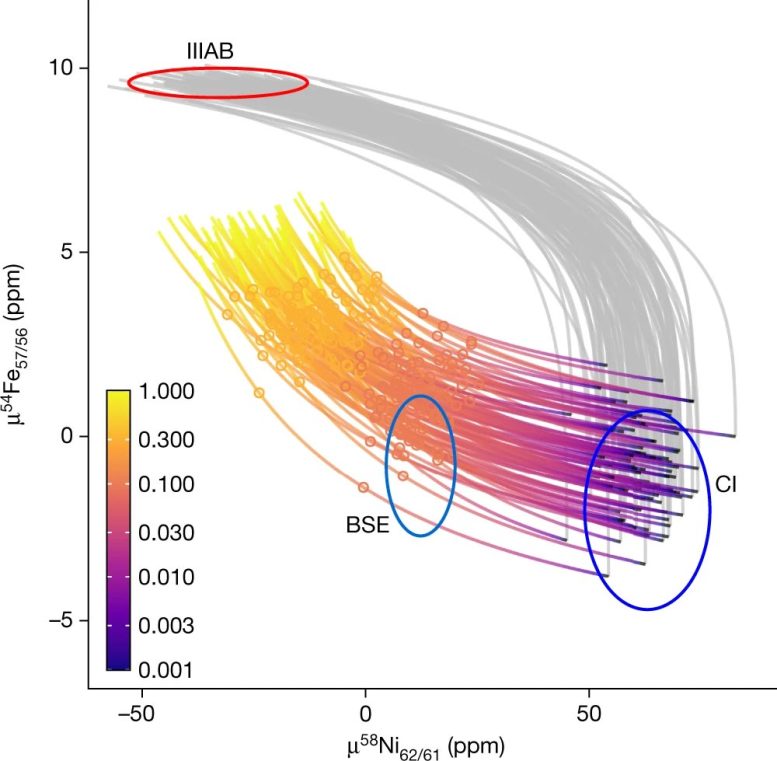
Earth formed in a few million years, much quicker than previously thought, through the rapid absorption of pebbles, dust, and icy particles, according to a new study from the University of Copenhagen. This finding enhances the likelihood of other habitable planets in the Universe due to the byproduct of water from this formation process.
When we walk around in our everyday life, we might not think of the Earth itself very often. This planet is, however, the foundation of our existence, providing the air we breathe, the water we drink, and the gravity that holds us to the ground.
Until recently, researchers believed that it took over 100 million years for Earth to form, with water being delivered by fortuitous collisions with water-rich asteroids such as comets. A new study from the University of Copenhagen, however, suggests that Earth’s formation might not have been a matter of pure luck.
A New Theory of Earth’s Formation
Professor Martin Bizzarro of the Globe Institute and co-author of the study explains, “We show that the Earth formed by the very fast accumulation of small millimeter-sized pebbles. In this mechanism, the Earth was formed in just a few million years. It appears that the presence of water on Earth is a byproduct of its formation.”
The research results indicate that Earth was created much faster than previously thought, and the presence of water is an anticipated outcome of this formation process. This information has significant implications for our understanding of planets outside our Solar System.
Implications for Habitability in the Galaxy
“With this new planet formation mechanism, the chance of having habitable planets in the galaxy is much higher than we previously thought,” Bizzarro says. Habitability is the potential for a planet to have the right ingredients at its surface for life to develop, and water is a key ingredient.
Associate Professor Martin Schiller, also a part of the study, elaborates, “People have debated how planets form for a long time. One theory is that planets are formed by the gradual collision of bodies, progressively increasing their size over 100 million years. In this scenario, the presence of water on Earth would need a sort of chance event.”

Role of Dust Particles in Earth’s Formation
A paradigm shift in this belief, however, is introduced by the new study, which offers a fresh theory of Earth’s creation. “There was a disk around the young Sun where the planets were growing. The disk was filled with small dust particles. Once a planet reaches a certain size, it sort of acts like a vacuum cleaner, sucking up all that dust very quickly, which contributes to its growth to Earth size in just a few million years,” explains Ph.D. student Isaac Onyett, the corresponding author of the study.
This “vacuuming” of small dust particles played a pivotal role in Earth’s formation and ensured that water was delivered to our planet. The disk also contained icy particles, which were absorbed along with the dust, contributing to the presence of water during Earth’s formation. This shift in understanding raises the probability of water being present on other planets.
Predicting Water on Other Planets
“This theory would predict that whenever you form a planet like Earth, you will have water on it. If you go to another planetary system where there is a planet orbiting a star the size of the Sun, then the planet should have water if it is in the right distance,” asserts Bizzarro.
The researchers used silicon isotopes to understand the mechanisms and timescales of planet formation. By analyzing the isotopic composition of over 60 different meteorites and planetary bodies, the team established genetic relationships between rocky planets like Earth and Mars and other celestial objects. This approach offered insight into the types of building blocks that assembled to form Earth and the process by which they came together.
Reference: “Silicon isotope constraints on terrestrial planet accretion” by Isaac J. Onyett, Martin Schiller, Georgy V. Makhatadze, Zhengbin Deng, Anders Johansen and Martin Bizzarro, 14 June 2023, Nature.
DOI: 10.1038/s41586-023-06135-z
Never miss a breakthrough: Join the SciTechDaily newsletter.
2 Comments
This ties in with the new evidence that Mars formed within five million years and that the system formed within the first hundred million years [“Evidence for very early migration of the Solar System planets from the Patroclus–Menoetius binary Jupiter Trojan”, Nature 2018]. With the Moon formation impact dated to about fifty million years in, we have a consistent series of evidence.
The new paper is a bit of tight squeeze of lots of data, e.g. the suggested mass of the Theia impactor at 40 % current Earth is twice the usual suggestion. But such masses has been suggested before, and if they clear the orbital dynamic criteria (such as resulting rotation rate and tilt) it works.
I already said that the earth went through many stages to have water and oxygen, out of a thousand trillion trillion, maybe there is one like Earth in the galaxies